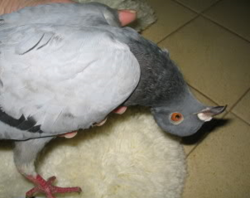Pigeon Paramyxovirus
Pigeon paramyxovirus (PPMV1) is the name of the disease when pigeons are infected with avian paramyxovirus type 1. The virus is present in most countries, spreads rapidly and can cause high rates of pigeon illness and death.
The first Australian detection was in Victoria in August 2011. It has since spread and become endemic in domestic and feral pigeon populations in Victoria, NSW, Tasmania and South Australia. The disease has also been reported to affect a spotted turtle dove (an introduced species) and a predatory sparrow hawk (a native species).
Paramyxovirus strains are generally capable of affecting other avian species, including poultry. However, PPMV1 does not appear to cause disease in poultry.
The virus is considered a minor zoonosis. This means human infection can occur, but symptoms are generally mild. Symptoms include conjunctivitis or mild flu-like symptoms. Direct, close contact with infected birds increases the risk of human infection.
In pigeons, signs of PPMV1 infection vary and can include any of the following:
- gastrointestinal signs – vomiting/regurgitation, diarrhoea
- neurological signs – twisting of the neck, circling, head flicking
- respiratory signs – laboured breathing, runny eyes and beak
- general signs – lethargy, death without apparent signs.


Infected birds shed the virus in their faeces and other discharges.
Spread of PPMV1 occurs from the movement of birds or bird products (e.g. feathers or eggs), or from contaminated people, clothing, surfaces or equipment.
Once the virus has been shed from a bird, PPMV1 can survive for several weeks in the environment.
Diagnosis
Many other bird diseases can cause similar signs to PPMV1. Confirmation of PPMV1 requires laboratory analysis.
Protection from spread
Biosecurity measures including vaccination of birds can help protect against spread of the virus.
Organisers of pigeon shows and races should ensure that only vaccinated birds are allowed to take part in these activities.
Biosecurity
The primary defence against PPMV1 is to prevent introduction of the disease by implementing the following biosecurity procedures:
- Keep good hygiene:
- Clean/disinfect footwear, hands and clothes after bird contact.
- Regularly remove faecal material from lofts and other housing.
- Keep lofts and equipment clean by using detergent-based cleaning chemicals.
- Have a final disinfection step of housing, transport, feeding and watering equipment after cleaning these surfaces first with detergent-based cleaning chemicals.
- Bird management:
- Quarantine new or returning birds for at least 2 weeks before introducing to the rest of the flock.
- Limit unnecessary visitors to where you keep your birds.
- Prevent contact with wild birds and droppings.
Vaccination
There is no registered PPMV1 vaccine for use in pigeons in Australia. However, Newcastle Disease (ND) vaccines registered for use in chickens are available for ‘off label’ use in pigeons with the written instruction of a veterinarian.
Use of the inactivated (killed) ND vaccines in 2 applications at 4 weeks apart has been shown to be a safe and effective vaccination program against PPMV1 in pigeons.
Injection sites are subcutaneous (under the skin) at the base of the neck or in the loose skin between the leg and body.
Inactivated vaccines must not be frozen. They should be kept at the manufacturer's recommended temperature, which is usually between 4 ºC and 8 ºC.
Only healthy pigeons in healthy flocks should be vaccinated. It is important to vaccinate all the pigeons in a loft or house to optimise herd immunity. Pigeons should not receive their first dose until they are at least 4 weeks of age. An annual booster vaccination is highly recommended for all pigeons.
Reporting
PPMV1 is a notifiable disease in Victoria, meaning a person who suspects or confirms that birds are infected with PPMV1 must notify Agriculture Victoria within 12 hours.
There are 3ways to notify Agriculture Victoria of notifiable diseases:
- Call the Emergency Animal Disease Hotline on 1800 675 888 (24 hours a day, every day of the year).
- The Notify Now app allows users to send high-quality geolocated photographs of the affected animals, with the owner’s details and property identification code (PIC).
- A completed Disease notification form
 [MS Word Document - 80.3 KB] can be emailed to cvo.victoria@agriculture.vic.gov.au
[MS Word Document - 80.3 KB] can be emailed to cvo.victoria@agriculture.vic.gov.au